1lumen selects and reviews products personally. We may earn affiliate commissions through our links, which help support our testing.
Fenix TK22R review

Fenix TK22R specifications
| Brand & Model | Fenix TK22R |
|---|---|
| Flashlight category | Tactical flashlight |
| LED | Luminus SST-70 6500K |
| Max. output | 3200 lumens |
| Max. beam distance | 480 meters |
| Max. beam intensity | 57,400 cd |
| Battery config. | 1*21700 |
| Onboard charging | USB-C |
| Main modes | 4 |
| Blinkies | Strobe |
| Waterproof | IP68 |
| Review publication date | April 2024 |
Review intro:
Fenix is a name brand in the flashlight world, having delivered high quality lights for well over 20 years now. Their specialities are primarily outdoor activity lights (camping, hiking, etc.) and tactical or duty lights. The TK22R is the latter. An evolution of the TK22 TAC, which we reviewed as well, the TK22R adds USB-C charging and morphs the control ring into a dial for similar, but slightly different control. Interestingly, the TK22R raises luminous output, while losing candela and throw, but is it worth it? Let’s find out.
What’s in the package
Fenix lights come in a shelf-worthy package, which is good because they’re one of the few flashlight brands you can find in physical stores! The box is black with orange highlights and is covered with images of the light and specifications. Very useful. Inside, there’s a molded plastic tray which holds the light itself on top and the accessories underneath. It’s all one piece, so when you pull it out, the accessories don’t spill everywhere. Overall, high quality packaging.
The contents of the box include:
- Fenix TK22R, with Fenix ARB-L21-5000 V2.0 21700 lithium-ion battery inside and clip installed
- Lanyard
- USB-A to USB-C charging cable
- Holster
- Instruction manual
- Warranty card
- Advertisement for the Fenix HM70R




Flashlight in use, Build Quality, and Warranty
Fenix makes tough lights and the TK22R is no exception. HAIII anodized aluminum keeps it in one piece, and dual springs keep the battery connected regardless of shaking or impact for uninterrupted service. It’s an easy light to hold with or without gloves due to the ringed knurling on the body and parallel knurling on the tail cap.
The Fenix TK22R, and really all of the TK series, is a bit too large for pants pocket carry, so a holster is included. It’s a pretty simple affair; a single strip of webbing with stiff, woven nylon sides and hook and loop closure comprise most of it. Other than that, there are two belt loops, one fixed and one with hook and loop closure, and a plastic D-ring above that for attaching a carabiner or something similar on the back. It does the job and there isn’t much else to say about it. There’s also a clip included, which only holds it as deep as the tail. The clip is stiff and feels secure against the light.
With two “switches” on the tail, the TK22R is definitely a dedicated tactical/duty light. The larger button is a forward-clicky switch so you can half-press for momentary, while the other is a dial, dubbed the “FlexiSensa Control tail switch,” which allows you to change between lockout, duty mode, and tactical mode. It’s actually recessed into the tail and almost flush with the rest of the tail cap, but can be easily turned in either direction to choose your desired mode.
There is a lip around 2/3 of the tail, but cut away near the FlexiSensa Control tail switch. There are also two holes for the lanyard on opposite sides of the lip, and those would prevent you from being able to tail stand the light, not that it can anyway, since the larger on/off button extends past that lip.
As this is a tactical/duty light, it’s designed to be held overhand, but you can handle it other ways, too. It does memorize the last used mode, which would make it easy to have both instant strobe and instant high mode. Rather than walking the dog, this might be better for playing frisbee with your dog at night to take advantage of the high throw.
Fenix uses a technology they call APF (Advanced Pulse-Frequency transmission system) which allows for a multifunction tail e-switch without the use of an inner tube or customized battery. This keeps the diameter and weight down, and allows for more freedom in battery choice. They also advertise that their thermal protection setup, which they call IOP (Internal Overheat Protection) is patented, and keeps the light below 65 degrees Celsius.
Fenix offers a limited lifetime warranty against manufacturing defects in their lights. What that means is that if the issue is within 15 days, the light will be replaced for free; if it’s within 5 years, they will repair it for free; and if it’s beyond 5 years, they will repair it for the price of the parts. However, if you buy the light from certain retailers, you will have to return it to that retailer instead of working with Fenix on warranty issues.







LED, Lens, Bezel, Beam, and Reflector
Fenix has outfitted the TK22R with a Luminus SST-70, a 6V, quad die, 5050 emitter. While the SST-70 does not put out the most attractive light, it is pretty powerful, and that’s the point of a tactical light. The 6500K emitter is focused by a decently large, smooth reflector and covered by a glass lens with purple anti-reflective coating for maximum throw.
As a larger tactical flashlight, Fenix gave the TK22R a stainless steel, crenulated bezel, with three tungsten tips for glass breaking (which I have not tested).
On low, the SST-70 has a very green tint, which gets more neutral as the power increases, but the hotspot’s corona is still slightly yellow on turbo. If it came in closer to 6500K rather than the ~6000K I measured, it would’ve been green instead. There’s a circle of usable spill, though with the smooth reflector, most of the light’s power is going towards projecting the hotspot as far as possible. The hotspot itself is a good size, thanks to the larger reflector, which provides better visibility downrange than a smaller light.
Spectral measurements:
I used an Opple Light Master Pro to measure the flashlight at 2 meters distance.
| Mode: | CCT: | CRI Ra: | duv |
|---|---|---|---|
| Turbo | 5935 K | 67.0 | 0.008 |



Dimensions and its competition
Dimensions:
| Fenix TK22R | Millimeters | Inches |
|---|---|---|
| Length | 158 mm | 6.2in |
| Head diameter | 40 mm | 1.6 in |
| Body diameter | 25 mm | 1.0 in |
Dimensions are rounded to the nearest millimeter and the nearest tenth of an Inch.
Weight:
| Fenix TK22R | Weight in grams | Weight in oz |
|---|---|---|
| Without battery: | 146 g | 7.7 oz |
| With battery | 217 g | 5.1 oz |
Weight is rounded to the nearest gram and tenth of an Oz.
Flashlight size comparison with its competition:
Group 1: Emisar D4 v2, Fenix TK11R, Convoy S2+
Group 2 tactical flashlights: Nitecore P23i, Fenix TK11R, Fenix TK22R, Nitecore SRT6i


Fenix TK22R UI: User Interface and Driver
The Fenix TK22R uses their FlexiSensa Control tail switch to select between lockout, duty mode, and tactical mode. I’ll cover both modes here.
Available modes:
- Duty mode
- Low, Medium, High, Turbo
- Tactical mode
- Turbo, Strobe
Available blinky modes:
- Strobe
From OFF:
- Press and hold: Momentary memorized level
- Single click: On to memorized mode
From ON:
- Half-press: Cycle through level (as listed in “Available Modes” above)
- 1 click: Off
Mode memory:
- Both modes memorize the last used level in that mode
Shortcuts:
- N/A
Low voltage warning/protection:
- The emitter will blink a few times when the voltage gets low
Strobe/blinkies
- To get to strobe, you must be in Tactical mode. Click to turn the light on, then half click to activate strobe.
Lock-out mode:
- Turn the FlexiSensa Control dial to lockout
PWM
- PWM is not visible with the naked eye or my phone camera
Additional/summary info on the UI:
- It’s a straightforward, simple UI, that’s all!
Fenix TK22R Charging and batteries
Fenix includes their ARB-L21-5000 V2.0 battery with the TK22R. It’s a 5000mAh protected 21700, though with the protection circuitry, it’s actually 75mm long. Thankfully, the TK22R has dual springs in the tube to keep it in place and allow standard-size unprotected 21700s to fit, too.
The Fenix TK22R has onboard USB-C charging and comes with a USB-A to USB-C cable for just that task. USB-C to USB-C also works, if you have that type of charger. You cannot use the light while Charging takes about 4 hours, as advertised, though that depends on how powerful your charger is. It seems to charge at or around 1A, which is a very acceptable rate. End voltage was around 4.11 – 4.13V.
Interestingly, the USB-C port on the light is hidden behind a collar at the base of the head, which you need to unscrew in order to access the port. Once open, you’ll find the battery status indicator light opposite the USB-C port. During charging, this is red, but it turns green once complete. There are o-rings at the top and bottom of where the collar meets the head, which allows for its IP68 rating.
A 250 mA capacity test on my Vapcell S4+ returned 4871mAh, a little shy of the 5000mAh rating.
| Charge type | Fits | No fit | Charge time |
|---|---|---|---|
| Flashlight with onboard USB-C | All 21700 sizes | N/A | 4 hours |





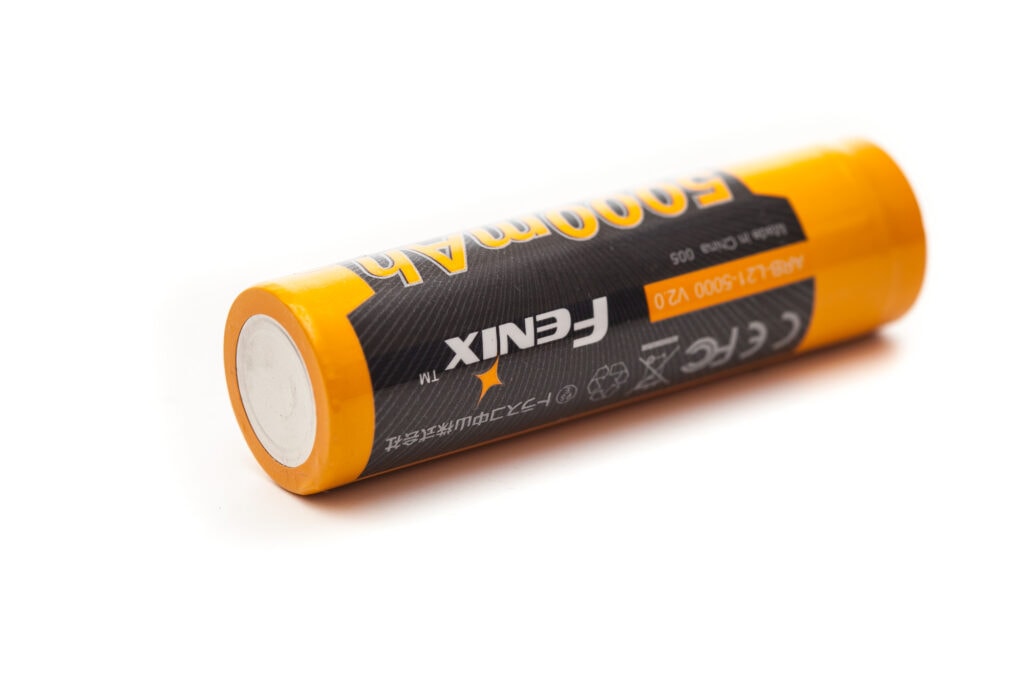
Performance test
Lumen measurements
How Lumens are Measured: Understanding ANSI FL1 Standards How Lumens are Measured: Understanding ANSI FL1 Standards: The ANSI FL1 standards specify that output in lumens should be measured 30 seconds after turning on, as this is the standardized time for measuring brightness according to the industry standard. This is why we focus on this part in our measurements. The ANSI FL1 standards require an ambient temperature of 22 ± 3°C. We record the ambient the ambient temperature to identify potential reasons for any observed discrepancies.To obtain these numbers, I used an integrated sphere and Extech SDL400 data logging lux meter. Measurements have been calibrated using a standardized calibration light provided by 1Lumen.
Overall, the TK22R missed its mark on lumen measurements, though at first turn on with a fully charged battery, turbo does slightly and briefly exceed spec, but by 30 seconds it’s already dropped by 800 lumens. Turbo and high eventually converge around 800 lumens, which is a good amount of light to sustain for the remainder of the runtime. Medium’s 327 lumens are also pretty useful, and low lasts so long at 25 lumens, that I didn’t bother trying to test it.
| Mode | Specified | Turn on | 30 sec. | 10 min. |
|---|---|---|---|---|
| Low | 30 | 33 lm | 33 lm | 33 lm |
| Med | 350 | 327 lm | 327 lm | 324 lm |
| High | 1000 | 935 lm | 930 lm | 898 lm |
| Turbo | 3200 lm | 3213 lm | 2392 lm | 808 lm |
| Turbo at 3.6V | – | 2178 lm | 1500 lm | 806 lm |
Ambient temperature during testing:
- 21 °C
I was unable to measure any amperage draw aside from one mode measuring 2.8A.
Fenix TK22R Battery Life: Runtime graphs
How Runtimes are Measured: Understanding ANSI FL1 Standards About ANSI FL1 runtime standards: The runtime is measured until the light drops to 10% of its initial output (30 seconds after turning on). This does not mean that the flashlight is not usable anymore. The last column shows how long the light actually works till it shuts off. If there is a + symbol, it means that the test was stopped at that particular point, but the light was actually still running. This happens on certain occasions, with certain drivers, firmware, or batteries.To obtain these numbers, I used an integrated sphere and Extech SDL400 data logging lux meter. Measurements have been calibrated using a standardized calibration light provided by 1Lumen.
It’s good to see the flat, regulated output of each level after the initial step down. Unfortunately, medium fell way short of the specified runtime. The others were closer, though. In any mode, once it drops to a moonlight-like level, it will keep shining for quite a long time, though that’s not the most useful tactical mode.
| Mode | Specified | Runtime (ANSI FL1) | Time till shut off |
|---|---|---|---|
| Low | 50h | – | – |
| Med | 7h 45min | 5h 53min | 15h 44min |
| High | 2h 35min | 2h 52min | 10h 43min |
| Turbo | 2h 15min | 2h 02min | 10h 36min |



Peak beam intensity and beam distance measurements
About Peak beam intensity: Understanding ANSI FL1 Standards About peak beam intensity The calculated value of distance in meters at which the flashlight produces a light intensity of 0.25 lux. (0.25 lux is about the brightness of a full moon shining on an object). This means that the intensity has decreased so much, it becomes difficult to see darker objects, or objects that don’t reflect light. The columns ‘Meters’ and ‘Yards’ use rounded numbers.The numbers for candela were obtained with an Extech SDL400 data logging lux meter at 5 and 15 meters, then averaged.
Interestingly, the TK22R exceeded its throw levels… until you get to turbo. 50,000 candela is nothing to sneeze at, but short of the 57,400 that Fenix claims. However, as mentioned in the lumen measurement section, the TK22R did hit the 3200 lumen spec at turn on, giving off over 76,000 candela for a fraction of a second.
| Mode | Specified | Candela measured | Meters | Yards |
|---|---|---|---|---|
| Low | 505 cd | 794 cd | 56 m | 62 yd |
| Medium | 6000 cd | 7715 cd | 176 m | 192 yd |
| High | 17,400 cd | 22,289 cd | 299 m | 327 yd |
| Turbo | 57,400 cd | 50,546 cd | 450 m | 492 yd |
| Turbo, on | – | 76,613 cd | 554 m | 605 yd |
Ambient temperature:
- 21 °C
Beamshots
Camera settings and distance: These were taken with a Samsung Galaxy S22+ using pro mode and the following settings: 0.5sec, ISO200, 5000K. Please note that in this mode, exposure value (EV) is automatically controlled and set to -2.0 for low and medium and -0.7 for high and turbo.
Distance to the other end of the playing field is 100 meters.
Beamshots of the following flashlights compared:
- Fenix TK11R
- Fenix TK22R
- Nitecore P23i
- Nitecore SRT6i
Please note that the following beamshots are mainly intended to showcase the beam pattern and beam quality, rather than overall performance. These images are typically taken directly after activation, and in different seasons or weather conditions, and therefore do not fully represent its overall performance. For accurate performance metrics, such as output, beam distance, and runtimes, you need to look at the performance section of this review.



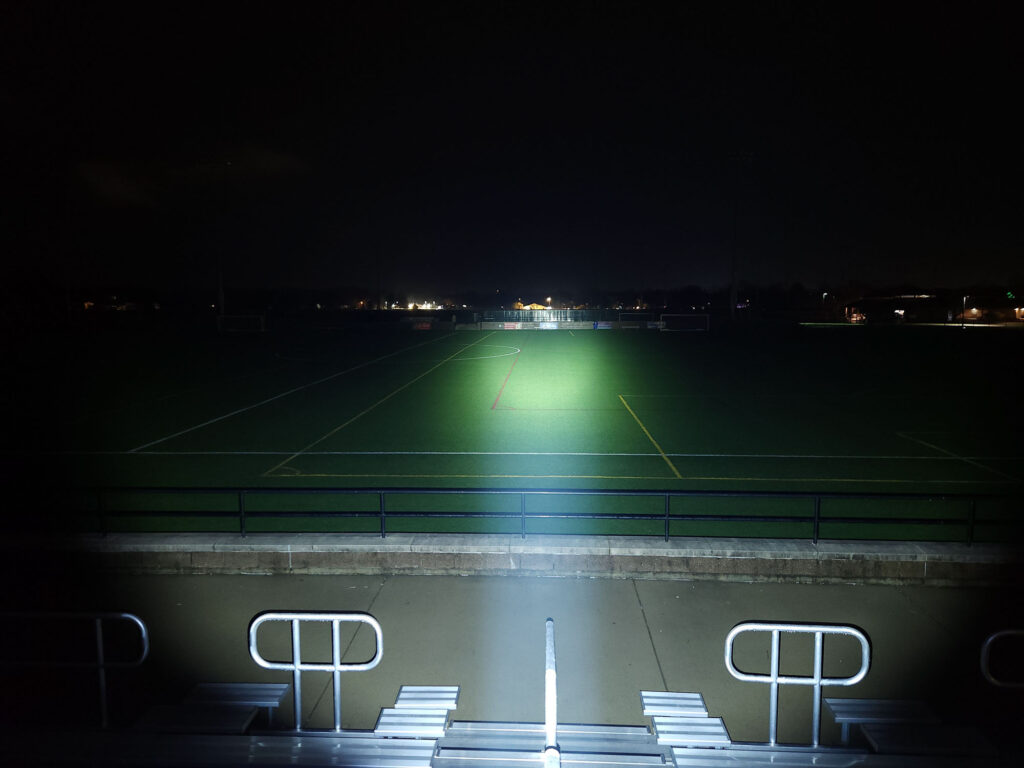
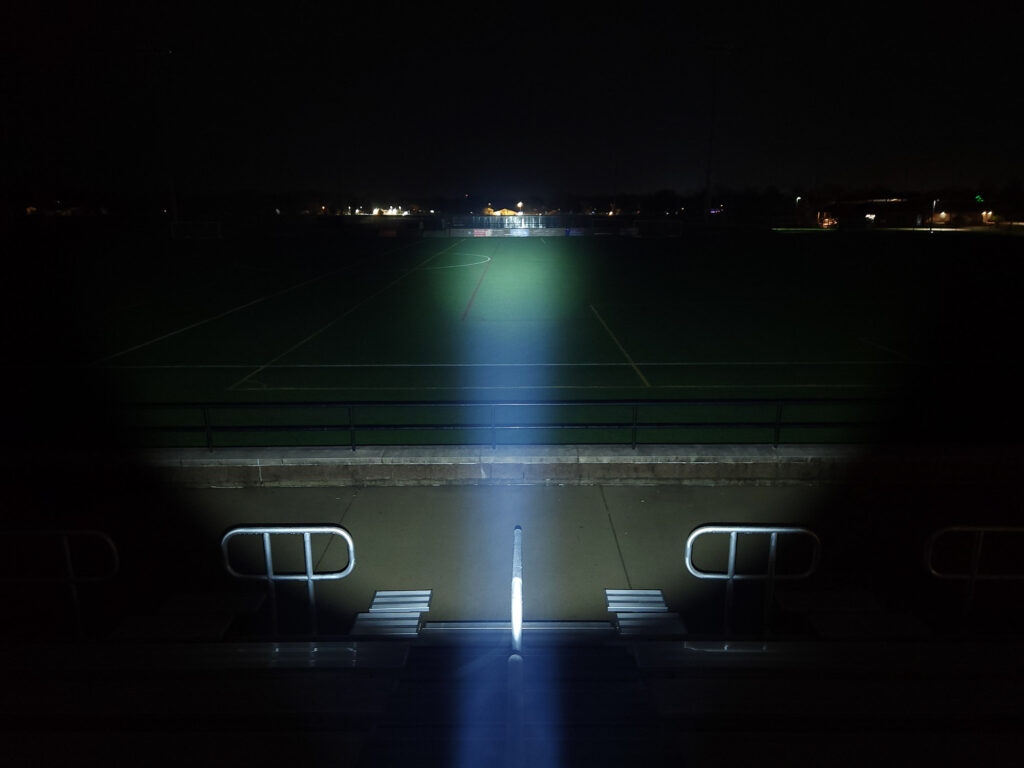
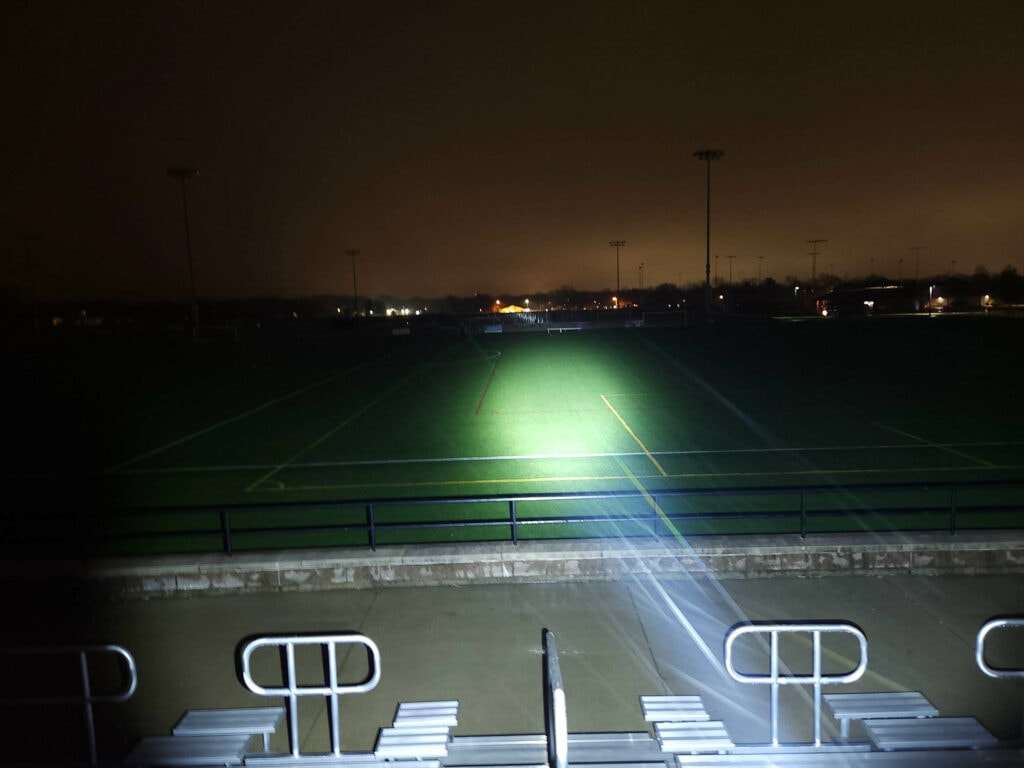
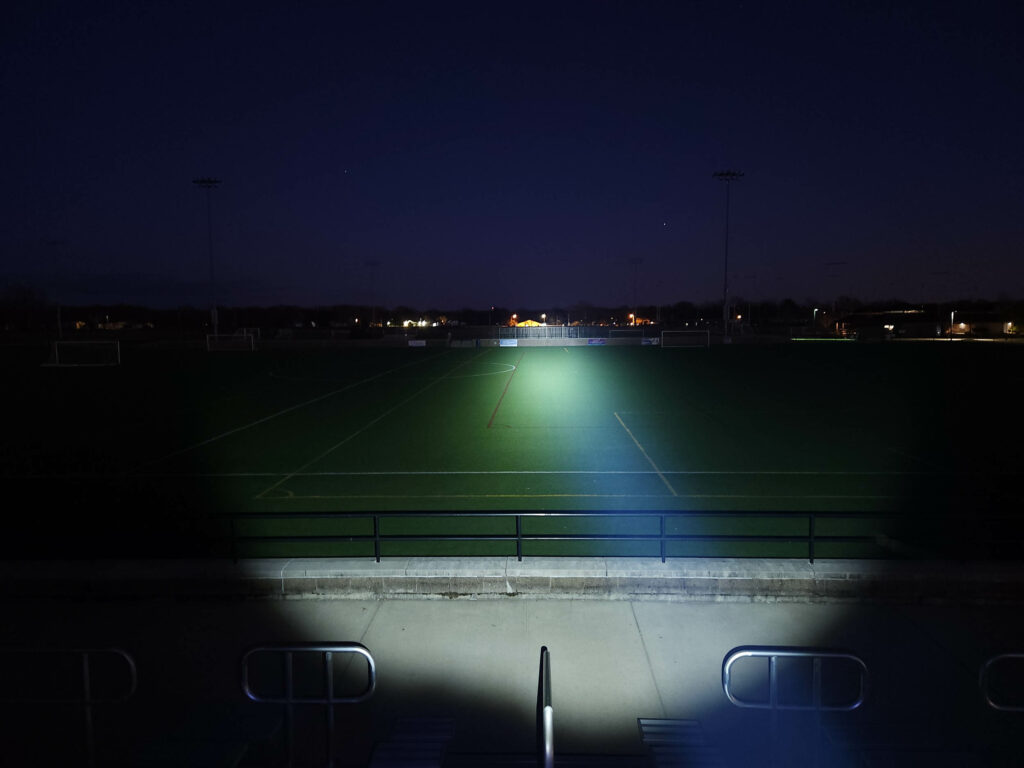
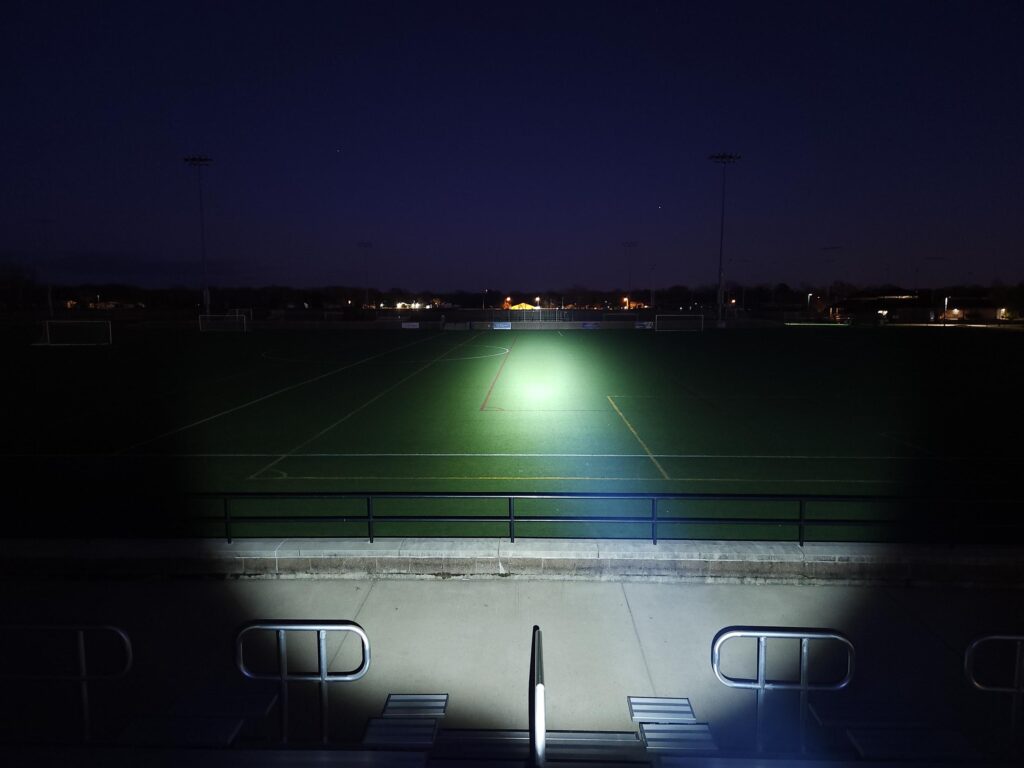
Disclaimer: This flashlight was sent to us for review at no cost by Fenix Lighting US. We have not been paid to review, nor have we been holding back on problems or defects.
Final Verdict
Pros
- FlexiSensa Control dial makes it easy to switch between duty and tactical modes
- Simple UI
- Long lasting, stable output
- Lots of candela and throw
Cons
- Lumens and runtime/battery capacity below spec
- Not entirely instant access to strobe
Explanation on star ratings:
1: Avoid: a match would be a better choice – 2: Poor: significant defect or issues; almost unusable – 3: Average: some defects or issues; but still usable 4: Good: recommended (minor issues) – 5: Great: highly recommended

4.5 stars: ★★★★⋆
While our star rating provides a reliable indicator, we encourage you to read the full review to make an informed decision based on your own needs and preferences.
Fenix’s TK22R comes from the company’s strong TK line of tactical lights, and it lives up to its heritage. With a tail switch and the FlexiSensa Control dial, it’s easy to switch between duty and tactical modes for versatility. However, in tactical mode, you have to full click then half press to get in and out of strobe which isn’t what I’d call instant access.
Unfortunately the TK22R doesn’t meet the specifications set forth by Fenix, but it’s still undeniably powerful. It’s also nice to see well-regulated, sustained output for those long-use sessions.
If you’re in the market for a tactical light, I see no reason why you shouldn’t include the TK22R in your search, and while it doesn’t hit every mark, I still give it a 4.5 star rating.
Buy your Fenix TK22R with a discount
Get 10% off every purchase at Fenix Lighting US, by using our exclusive 1lumen discount code: 1lumen10
1lumen selects and reviews products personally. We may earn affiliate commissions through our links, which help support our testing.